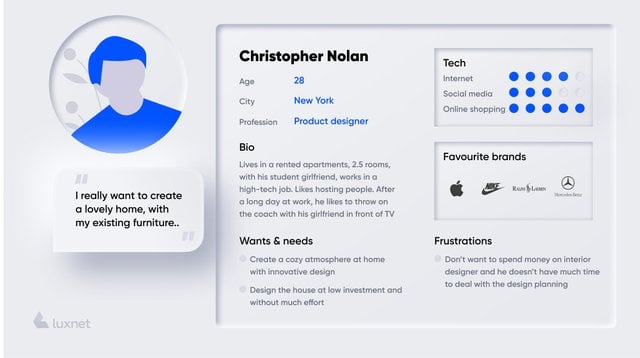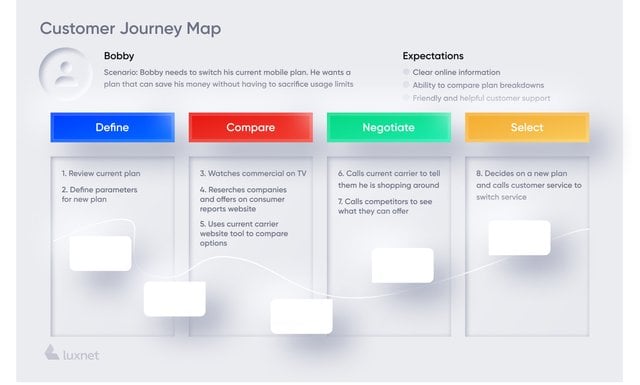It is a well-known fact that the better you know your users, the more likely your business is to serve their interests and make a profit for you. In this situation, it is important to study the touchpoints between the customer and the business. Customer experience maps can really help here. Map methods push for logical decisions and encourage continuous business development.
What is a customer experience map?
It is a well-known fact that the better you know your users, the more likely your business is to serve their interests and make a profit for you. In this situation, it is important to study the touchpoints between the customer and the business. Customer experience maps can really help here. Map methods push for logical decisions and encourage continuous business development.
A customer experience map, also known as a Customer Journey Map or User Journey Mapping, is a graphical representation of contact points of the user and the business from the moment of their first interaction. This is a powerful technique to understand the needs, pain points and customer motivation - that is, customer experience when buying a product or service. Many companies conduct a considerable sociological research to study the needs and desires of their customers. However, often these data are not enough to find out what the customer does not like, what distracts him/her from the purchase or why he/she remains dissatisfied afterwards.

template of User Experience Map
In general, graphical representations of business operations and customer needs can be summarized in one word - User Experience Map. It (UX map) in all its aspects has important tasks: to improve customer service and, consequently, increase the company's profit.
Right away we are going to tell you about two main terms that go with this article.
The first one is the User Journey. It is the user's path and this term is used when there is a need to track the "journey" of the customer throughout the website, find out which buttons he/she presses, which sections he/she goes to, and not just that.
The second one is Customer Experience. It is the experience of the customer that includes the customer's path, touchpoints and the environment in which the customer is present when ordering a service.
User experience design tools
There are a lot of tools for designing a user experience. Such a map can take various forms by adapting to your main needs. We recommend you to use the following tools to create a customer experience map:
- Journey and visualization design: these are online and offline programs that can be used to create diagrams and other graphs in order to see the customer's journey on the website.
- Software for customers: this is the feedback that the user can use when receiving the service. This is a good tool for research maps that will definitely help because it gives the possibility to gather and involve quantitative and qualitative data from different channels and touchpoints.
- Collaboration software: this is a tool that helps to establish cooperation among all team members, as well as to avoid quarrels and mistakes.
Creation of user experience journey map
Step 1: Create a user persona
Give a name to the person from your target audience. Let's say you have a clothing store. Who comes there and for what? Create a user persona. For example, this is Anna, 32 years old, works in the business sphere. She loves pastel colours but hates "boring" clothes. She can spend a lot of money on jeans but she wants them to be of good quality. Moreover, at the time of purchase, she will not refuse to have a cup of coffee. That is, write down all the details and make an exact portrait of one of the clients. This will help you during strategic planning because you will know that you work for people, who have their feelings and preferences, but not for the vague and imaginary word "a buyer".

an example of user persona
Step 2: Identify the stages the user is following
UX journey map usually has several stages. This is the movement of the customer from visiting a real store or website to making a purchase. Thus, the map can visualize the main goal which he/she is trying to achieve. You need to analyze and break into stages all the steps that the customer has to take. For instance, speaking about the same clothing store, it is necessary to ask: What steps does the user take during the purchase? And the answers (stages) will be the following:
- Stage No.1: coming to the store.
- Stage No.2: familiarization with an assortment.
- Stage No.3: help and advice from a consultant.
- Stage No.4: making a choice.
- Stage No.5: making a purchase.
You should analyze what the user does and feels during each stage and then try to make the process of buying a product or service as easy as possible.
Step 3: Identify customer interactions
At this stage, it is necessary to identify the touching points with the customer. How does he/she interact with your company and employees in particular? What is convenient for him/her and what is not? Where does the customer perhaps need some support?
Step 4: Conduct the research
At this stage, communicate more with real users. Ask them what they like and what they don't. You can also use social media, classified ads, and even third-party organizations that specialize in researches.
Step 5: Determine the friction points
After making all the previous stages, take one step back. Have a look at the whole picture and determine the points of friction. Go through all the stages with your team one more time and identify all possible ways to improve the situation.
Step 6: Summarize

What other types of user experience mapping are there?
If you really want to change your company for the better, you can also implement empathy maps into your research. The empathy map is a kind of user experience technique which aims to put the developer/manager/project manager in the user’s place. The map allows you to create user personas, and also helps to solve particular problems of the product. In order to create the empathy map, you must literally put yourself in the user's shoes. You should feel, see and hear what the user does in everyday life.
Another variant is design thinking or service design. It is a process that studies how the customer feels during the life cycle of interaction with the company. Actually, this is a kind of equilibrium strategy: the better the customers feel when they receive services, the more money your business will earn.
Besides, you have to keep in mind: any of these maps need visualization. Therefore, it is better to draw up all design processes in graphs and diagrams.
Conclusion
All the maps that we mentioned above are necessary for the development of your business. Firstly, visualization helps to better understand the weaknesses and friction points in the company. Secondly, UX design, which defines the usability for the client, plays a significant role too. And if it is developed on time and constantly improved, both the user and the business will be satisfied and get pleasure from it.
